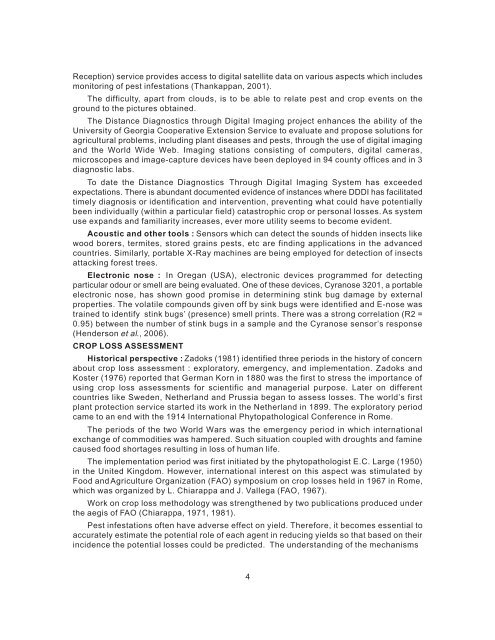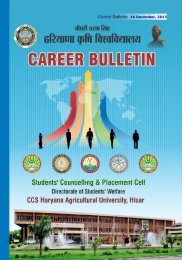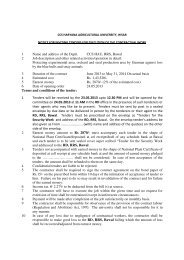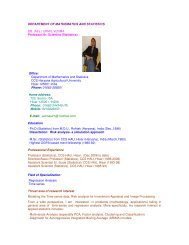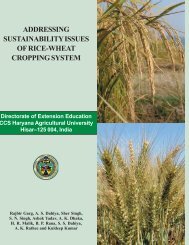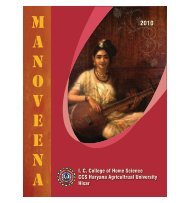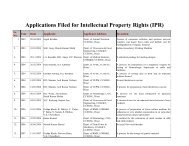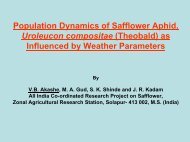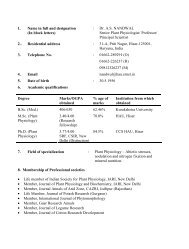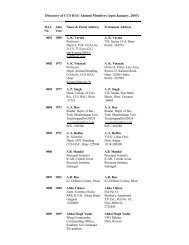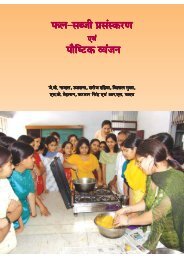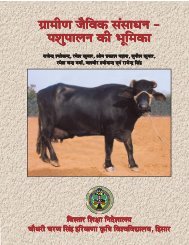Foreword - CCS HAU, Hisar
Foreword - CCS HAU, Hisar
Foreword - CCS HAU, Hisar
You also want an ePaper? Increase the reach of your titles
YUMPU automatically turns print PDFs into web optimized ePapers that Google loves.
Reception) service provides access to digital satellite data on various aspects which includes<br />
monitoring of pest infestations (Thankappan, 2001).<br />
The difficulty, apart from clouds, is to be able to relate pest and crop events on the<br />
ground to the pictures obtained.<br />
The Distance Diagnostics through Digital Imaging project enhances the ability of the<br />
University of Georgia Cooperative Extension Service to evaluate and propose solutions for<br />
agricultural problems, including plant diseases and pests, through the use of digital imaging<br />
and the World Wide Web. Imaging stations consisting of computers, digital cameras,<br />
microscopes and image-capture devices have been deployed in 94 county offices and in 3<br />
diagnostic labs.<br />
To date the Distance Diagnostics Through Digital Imaging System has exceeded<br />
expectations. There is abundant documented evidence of instances where DDDI has facilitated<br />
timely diagnosis or identification and intervention, preventing what could have potentially<br />
been individually (within a particular field) catastrophic crop or personal losses. As system<br />
use expands and familiarity increases, ever more utility seems to become evident.<br />
Acoustic and other tools : Sensors which can detect the sounds of hidden insects like<br />
wood borers, termites, stored grains pests, etc are finding applications in the advanced<br />
countries. Similarly, portable X-Ray machines are being employed for detection of insects<br />
attacking forest trees.<br />
Electronic nose : In Oregan (USA), electronic devices programmed for detecting<br />
particular odour or smell are being evaluated. One of these devices, Cyranose 3201, a portable<br />
electronic nose, has shown good promise in determining stink bug damage by external<br />
properties. The volatile compounds given off by sink bugs were identified and E-nose was<br />
trained to identify stink bugs’ (presence) smell prints. There was a strong correlation (R2 =<br />
0.95) between the number of stink bugs in a sample and the Cyranose sensor’s response<br />
(Henderson et al., 2006).<br />
CROP LOSS ASSESSMENT<br />
Historical perspective : Zadoks (1981) identified three periods in the history of concern<br />
about crop loss assessment : exploratory, emergency, and implementation. Zadoks and<br />
Koster (1976) reported that German Korn in 1880 was the first to stress the importance of<br />
using crop loss assessments for scientific and managerial purpose. Later on different<br />
countries like Sweden, Netherland and Prussia began to assess losses. The world’s first<br />
plant protection service started its work in the Netherland in 1899. The exploratory period<br />
came to an end with the 1914 International Phytopathological Conference in Rome.<br />
The periods of the two World Wars was the emergency period in which international<br />
exchange of commodities was hampered. Such situation coupled with droughts and famine<br />
caused food shortages resulting in loss of human life.<br />
The implementation period was first initiated by the phytopathologist E.C. Large (1950)<br />
in the United Kingdom. However, international interest on this aspect was stimulated by<br />
Food and Agriculture Organization (FAO) symposium on crop losses held in 1967 in Rome,<br />
which was organized by L. Chiarappa and J. Vallega (FAO, 1967).<br />
Work on crop loss methodology was strengthened by two publications produced under<br />
the aegis of FAO (Chiarappa, 1971, 1981).<br />
Pest infestations often have adverse effect on yield. Therefore, it becomes essential to<br />
accurately estimate the potential role of each agent in reducing yields so that based on their<br />
incidence the potential losses could be predicted. The understanding of the mechanisms<br />
4


